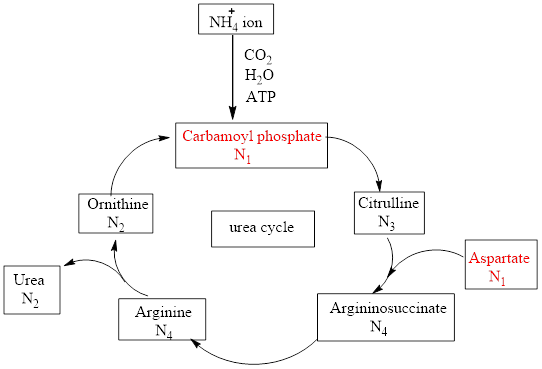
Concept explainers
(a)
Interpretation: To characterize carbamoyl phosphate in terms of nitrogen content
Concept introduction: Urea cycle is a cyclic biochemical pathway that involves the production of urea using ammonium ions and aspartate molecules as nitrogen sources. It converts toxic ammonium ion to urea which is then excreted from the body in urine. Urea cycle can be explained in terms of the nitrogen content of all the compounds participating in the urea cycle as follows:

(b)
Interpretation: To characterize ammonium ion in terms of nitrogen content
Concept introduction: Urea cycle is a cyclic biochemical pathway that involves the production of urea using ammonium ions and aspartate molecules as nitrogen sources. It converts toxic ammonium ion to urea which is then excreted from the body in urine.
Urea cycle can be explained in terms of the nitrogen content of all the compounds participating in the urea cycle as follows:

(c)
Interpretation: To characterize fumarate in terms of nitrogen content
Concept introduction: Urea cycle is a cyclic biochemical pathway that involves the production of urea using ammonium ions and aspartate molecules as nitrogen sources. It converts toxic ammonium ion to urea which is then excreted from the body in urine. Urea cycle can be explained in terms of the nitrogen content of all the compounds participating in the urea cycle as follows:

(d)
Interpretation: To characterize urea in terms of nitrogen content
Concept introduction: Urea cycle is a cyclic biochemical pathway that involves the production of urea using ammonium ions and aspartate molecules as nitrogen sources. It converts toxic ammonium ion to urea which is then excreted from the body in urine. Urea cycle can be explained in terms of the nitrogen content of all the compounds participating in the urea cycle as follows:

Want to see the full answer?
Check out a sample textbook solution
Chapter 15 Solutions
Organic And Biological Chemistry
 Organic And Biological ChemistryChemistryISBN:9781305081079Author:STOKER, H. Stephen (howard Stephen)Publisher:Cengage Learning,
Organic And Biological ChemistryChemistryISBN:9781305081079Author:STOKER, H. Stephen (howard Stephen)Publisher:Cengage Learning, General, Organic, and Biological ChemistryChemistryISBN:9781285853918Author:H. Stephen StokerPublisher:Cengage Learning
General, Organic, and Biological ChemistryChemistryISBN:9781285853918Author:H. Stephen StokerPublisher:Cengage Learning Chemistry for Today: General, Organic, and Bioche...ChemistryISBN:9781305960060Author:Spencer L. Seager, Michael R. Slabaugh, Maren S. HansenPublisher:Cengage Learning
Chemistry for Today: General, Organic, and Bioche...ChemistryISBN:9781305960060Author:Spencer L. Seager, Michael R. Slabaugh, Maren S. HansenPublisher:Cengage Learning Introduction to General, Organic and BiochemistryChemistryISBN:9781285869759Author:Frederick A. Bettelheim, William H. Brown, Mary K. Campbell, Shawn O. Farrell, Omar TorresPublisher:Cengage LearningChemistry: Matter and ChangeChemistryISBN:9780078746376Author:Dinah Zike, Laurel Dingrando, Nicholas Hainen, Cheryl WistromPublisher:Glencoe/McGraw-Hill School Pub Co
Introduction to General, Organic and BiochemistryChemistryISBN:9781285869759Author:Frederick A. Bettelheim, William H. Brown, Mary K. Campbell, Shawn O. Farrell, Omar TorresPublisher:Cengage LearningChemistry: Matter and ChangeChemistryISBN:9780078746376Author:Dinah Zike, Laurel Dingrando, Nicholas Hainen, Cheryl WistromPublisher:Glencoe/McGraw-Hill School Pub Co





